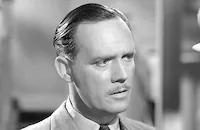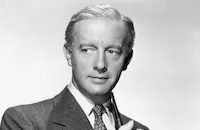Shoot First

Brief Synopsis
Cast & Crew
Robert Parrish
Joel Mccrea
Laurence Naismith
Denis Lehrer
Marius Goring
Karel Stepanek
Film Details
Technical Specs

Synopsis
After former U.S. Army colonel Robert Taine fires buckshot at Reimann, a suspected poacher on Taine's rented property in the English countryside, he discovers that Reimann has been mortally wounded. Unaware that a foreign spy named Hiart shot Reimann simultaneously, Bob blames himself for Reimann's death. When Bob encounters Hiart and his driver, Diss, who are surreptitiously looking for the body, neither admits to the shooting, and Bob later hides Reimann's body under a shrub. Later that night, Hiart's colleague, Magda Hassingham, discusses the incident with him. Magda's drunkard husband, the major landowner in the area, is ignorant of her involvement with enemy agents. Bob intends to bury Reimann the next day but when he returns to the site of the shooting, he unexpectedly encounters Peter Sandorski, a Polish operative for British military intelligence. Sandorski suspects that Bob killed his operative and now enlists his help with a secret operation. When British colonel Cartwright introduces Bob and his wife Cecily to government official Randall, Randall confirms Sandorski's identity and story and instructs Bob to cooperate with Sandorski. After Randall leaves, Bob confesses Reimann's accidental death to Cecily. That night Cecily insists on accompanying Bob and Sandorski to a nearby field where an enemy agent is expected to land by plane. While Cecily stays in the car, Bob and Sandorski observe Hiart, Magda and their assistants arrange landing beacons. When he overhears that the agent, identified as Lex, will be in town for only forty-eight hours, Sandorski decides to capture him. Sandorski and Bob re-route the plane's landing by moving a beacon, and Sandorski impersonates Hiart. Bob carries Lex to their car after the spy falls and hits his head, and Sandorski tosses grenades so they cannot be followed. While Bob and Cecily impersonate the Hassinghams, Sandorski drugs Lex so he will sleep. The next morning police investigate a fire caused by Sandorski's grenades, and Reimann's body is discovered during the investigation. Diss, meanwhile, attempts to locate Lex and learns about Bob and Cecily's unusual houseguests from their housekeeper's son, Tommy Powell. After police inspectors Matthews of Dorchester and Sullivan of Scotland Yard question Bob and take one of his boots to compare to the prints found near Reimann's body, Bob insists they all leave for London, where Lex has a meeting. On Bob's instruction, Mrs. Powell contacts Randall with a request to call off Scotland Yard. Hiart arrives in time to overhear her conversation and pursues them. Following a long drive, Bob, Cecily, Sandorski and Lex arrive at a train station where Randall makes contact with Cecily, who admits that Bob killed Reimann. While on the train to London, Cecily takes Lex's briefcase while he is asleep. Bob then meets Randall in a private compartment and, after bypassing a booby-trap, opens the briefcase and reviews the paperwork. At the London train station Hiart uses a broadcasting system to alert Lex, who then escapes with him. However, Randall and Sandorski arrest Lex the next day at Madame Tussaud's Wax Museum, after he passes an envelope to an unidentified spy. Lex and the spy are arrested, but Hiart and Diss flee. Sandorski shoots Diss during a pursuit in a stairwell, and Hiart is killed when he opens Lex's briefcase and it explodes. Randall later reveals to Bob and Cecily that Lex, a scientist, was brought to England to interpret stolen reports about British atomic weapons trials in Australia. He and Sullivan then inform a relieved Bob that it was Hiart who killed Reimann. Before departing, Sandorski cautions Cecily to remember that any future strange behavior of Bob's may be related to espionage.

Director

Robert Parrish
Cast

Joel Mccrea

Laurence Naismith
Denis Lehrer

Marius Goring
Karel Stepanek
Powys Thomas

Evelyn Keyes
Robert Dickens
Megs Jenkins
Ellis Irving

Patricia Laffan

Frank Lawton

Cyril Raymond

Herbert Lom

Roland Culver
David Hurst
Clement Mccallin
Jack Mcnaughton
Arnold Bell
Joan Hickson
Crew
Eric Ambler
L. Bulkeley
George Burgess
Ted Cotton
Ginger Croly
Ernest Holding
Ivan King
Russell Lloyd
Hans May
Stanley Pavey
Tom Simpson
Neville Smallwood
Raymond Stross
Gerry Turpin
Max Varnel
Constance Willis

Film Details
Technical Specs

Articles
Shoot First
The hero is Lieutenant Colonel Tanie of the United States Army, now passing his days with his wife Cecily (Evelyn Keyes) in the English countryside, where he has rented a stretch of uncultivated land in Dorset as a "shoot" for hunting small varmints and enjoying the great outdoors. On the prowl for rabbits one day, he spots a stranger who appears to be poaching on his territory, and decides to teach the trespasser a lesson by peppering his backside with buckshot. He fires off a load and hits his target, but he doesn't see what the movie shows us - that another stranger, hidden in the brush, has fired at the "poacher" at the same instant. Tanie walks over to the trespasser, assuming he gave the man a good scare, and is upset to learn that he's dead.
Instead of contacting the authorities, who might not believe this was the accidental outcome of a prank, Tanie hides the body, lies to Cecily about what he's been up to, and tries to ignore his uneasy conscience. Then he finds something extremely odd - a set of small spotlights hidden in the brush - and he also meets the movie's next important character: General Sandorski (Herbert Lom), a former Polish officer who's now a cloak-and-dagger undercover man. He informs Tanie that the lights are aircraft beacons set up by an espionage ring to guide a foreign agent on the way with secret papers. Tanie isn't sure Sandorski knows what he's talking about, and his doubts don't diminish when he learns that the general is living in a nearby mental institution. Sandorski turns out to be eccentric rather than crazy, however, and before long Tanie joins him in an improvised scheme to thwart the spies and uncover a nest of traitors, all without tipping off the police to the shooting that could land Tanie in prison. Other key players include Mr. Randall (Ronald Culver) of the British Secret Service, the duplicitous Hiart (Marius Goring), leader of the spy operation, and the Soviet agent Lex (David Hurst), who is fooled into thinking that Tanie and Sandorski are his friends and Hiart's operatives are his enemies, when it's actually the other way around.
Shoot First was adapted by Eric Ambler, one of the biggest names in British spy fiction, from Geoffrey Household's 1951 novel A Rough Shoot. (The film's original British title was Rough Shoot.) Household was a popular writer whose autobiographical statement is quoted on the dust jacket of this book. He says he started his career "as a conventional and overeducated Englishman," then became a "professional storyteller" before World War II. After writing his third novel in 1939 he "took a course of training for special intelligence duties," fulfilled assignments in Egypt and Greece, and spent the rest of the war "in comparative luxury as a security officer" in the Middle East region. In short, he knew a thing or two about international intrigue.
Household's history resembles that of his contemporary Ian Fleming, another English author with a background in wartime intelligence and a talent for spy stories. A Rough Shoot is a little like a James Bond novel, spinning a moderately suspenseful premise into a moderately engaging story. This said, however, Shoot First is nothing like a James Bond movie; its events are too modest, its effects are too restrained, and McCrea is no Sean Connery or Daniel Craig, even if he belongs to the same ruggedly handsome breed. Shoot First has more in common with various Hitchcock films, including Foreign Correspondent, another wartime espionage thriller with a British setting and McCrea in the leading role. The atomic secrets being smuggled by the Shoot First spies are what Hitchcock called a MacGuffin - something that has no meaning for the audience but gives the characters a good reason to chase, capture, outwit, and kill one another. The basic plot also has a Hitchcock-style structure: Tanie finds himself running from the police on one side and foreign agents on the other, just as Hitchcock heroes in pictures like The 39 Steps (1935) and North by Northwest (1959) are forced to do. The set-piece finale of Shoot First, culminating in London's famous Madame Tussaud's wax museum, offers another Hitchcockian touch, trying for the sort of last-minute capper that Hitchcock was so fond of, as in Foreign Correspondent, when a plane crashes into the sea and the viewer experiences it from the point of view of a camera in the cockpit.
In an early film review, the great French filmmaker and critic François Truffaut connected the dots between Shoot First and Hitchcock, but used the comparison to insult the movie. Shoot First, he wrote, "corresponds to the idea that half-witted critics have about Hitchcock, the 'master of suspense.' Here, all is bluff, faked, unseemly effects. Shot in England, this film breathes of English countryside, English soberness, English humor, English flatness, English nonexistence. Not one invention, not one detail, not a single idea." I think most moviegoers enjoy Shoot First more than Truffaut did, partly because it calls up memories of Hitchcock, and partly because of its excellent acting. Keyes is lively and strong as Cecily, and Lom, who's best remembered now for his six Pink Panther pictures, almost steals the picture as Sandorski, "making a completely engaging character out of what's intended as a caricature," to quote the Variety review. And not even Truffaut could find a bad word for McCrea, who must have enjoyed this sort-of-vacation from westerns very much.
Director: Robert Parrish
Producer: Raymond Stross
Screenplay: Eric Ambler; adapted from the novel A Rough Shoot by Geoffrey Household
Cinematographer: Stanley Pavey
Film Editing: Russell Lloyd
Art Direction: Ivan King
Music: Hans May
With: Joel McCrea (Tanie), Evelyn Keyes (Cecily), Herbert Lom (Sandorski), Marius Goring (Hiart), Roland Culver (Randall), Karel Stepanek (Diss), David Hurst (Lex), Frank Lawton (Hassingham), Patricia Laffan (Magda), Megs Jenkins (Mrs. Powell), Laurence Naismith (Blossom), Cyril Raymond (Cartwright), Denis Lehrer (Reimann), Powys Thomas (Ambulance Driver), Robert Dickens (Tommy), Ellis Irving (Wharton), Clement McCallin (Inspector Sullivan), Jack McNaughton (Inspector Matthews), Arnold Bell (Sergeant Baines), Joan Hickson (Woman Station Announcer)
BW-83m.
by David Sterritt

Shoot First
Quotes
Trivia
Notes
The working title of this film was Rough Shoot, which was also the film's British release title in February 1953. The opening and closing cast credits vary in order. According to the pressbook, Geoffrey Household's novel was originally serialized under the title Run from the Hangman; the publication and date have not been determined. Shoot First was filmed on location in England. Some scenes were shot in Madame Tussaud's Wax Museum in London.














